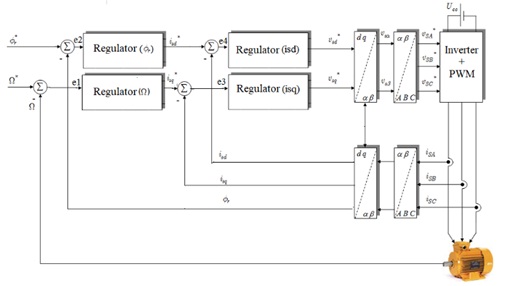Sliding mode sensorless control of an asynchronous motor based on an MRAS-type observer
DOI:
https://doi.org/10.57056/ajet.v8i1.91Keywords:
Asynchronous motor, variable structure control, sliding mode, sensorless control, MRAS observerAbstract
This work deals with the problem of speed control of a sensorless asynchronous motor. Conventional control laws by PI or PID for example, although still widely used, may prove to be insufficient or unsuitable. We then develop control laws by state feedback, their use nevertheless requires the measurement of the state vector. However, in many cases, sensors for measuring all the physical quantities are not available, essentially for cost reasons. An observer, which is a mathematical object, makes it possible to reconstruct this state vector from the only physical measurements available. In this context, we will propose the use of the sliding mode technique, which is a recursive control method and represents a tool for the study of dynamic stability. We will then approach the observers and in particular those resulting from the theory of the reference model (MRAS). In this proposed work, we are interested in the study of the asynchronous motor by the application of the sliding mode which is a relatively recent technique for nonlinear systems. It is combined with the vector control principle with oriented rotor flux to design robust machine control laws. The motor state quantities are estimated by the MRAS algorithm. A comparison of the performances is established to come out with general conclusions and in particular with regard to the use of the observer to estimate the quantities of state of the engine to control it later by this technique.
References
Palacios T, Mishra UK, and Sujan GK. GaN-Based. Transistors for High-Frequency Applications, In book: Reference Module in Materials Science and Materials Engineering. 2016. https://doi.org/10.1016/B978-0-12-803581-8.09256-0
Asahi H, Horikoshi Y, editors. Molecular Beam Epitaxy: Materials and applications for electronics and optoelectronics. John Wiley & Sons; 2019 Apr 15.
Schumacher B, Bach H, Spitzer P, and Obrzut J. Electrical Properties’, Springer Hand-book of Materials Measurement Methods. 2006; 431-484
Khuznetsova S, and Kukushkin A. Control Coefficient Application to the Study of Elec-tron Flow Distribution between Linear and Cyclic Electron Transport and the Conditions Es-sential for Appearance of Photosynthetic Oscillations, Photosynthesis: Mechanisms and Ef-fects. 1998; 2071-2074
Pareschi L, and Russo G. (An introduction to Monte Carlo method for the Boltzmann equa-tion, EDB science. 2001.
Negol A, Guyot A, and Zimmermann J. A. dedicated system for changed particles simula-tion using the Monte Carlo, Proceeding of IEEE International Conference on systems imple-mentation specific, architectures and processors (AASAP 97). 1997.
Zimmermann J. Study by the method of Monte Carlo phenomena of electron transport in silicon N-type stationary and nonstationary regimes. Application simulation submicron components, These, 1980.
Pesic I. Part Mocasim Overview, Process Simulation Framework Silvaco TCAD interactive tools. 2013.
Gupta MC, Ballato, J. . Second edition the Handbook of Photonics books, CRC Press Amazon France. 2016.
Zhou L, Smith DJ, McCartney MR, Katzer DS, Storm DF. Observation of vertical honeycomb structure in InAlN∕GaN heterostructures due to lateral, Journal Applied Physics Letters, 2017.
Mánuel JM, Morales FM, Lozano JG, González D, García R, Lim T, Kirste L, Aidam R, Ambacher O. Structural and compositional homogeneity of InAlN epitaxial layers nearly lattice-matched to GaN. Acta Materialia. 2010;58(12):4120-4125.
Carlin JF, Zellweger C, Dorsaz J, Nicolay S, Christmann G, Feltin E, Butté R, Grandjean N. () Progresses in III nitride distributed Bragg reflectors and microcavities using AlInN/GaN materials. physica status solidi (b). 2005;242(11):2326-2344.
Lorenz K, Franco N, Alves E, Watson IM, Martin RW, O’donnell KP. Anomalous ion channeling in AlInN/GaN bilayers: determination of the strain state. Physical review letters. 2016.;97(8):085501.
Wang K, Martin RW, Nogales E, Edwards PR, O’Donnell KP, Lorenz K, Alves E, Watson IM. Cathodoluminescence of rare earth implanted AlInN. Applied physics letters. 2016;89(13):131912.
Gadanecz A, Bläsing J, Dadgar A, Hums C, Krost A. Thermal stability of metal organic vapor phase epitaxy grown AlInN. Applied physics letters. 2007;90(22):221906.
Bellakhdar A, Telia A, Coutaz JL. An analytical model for the current voltage characteristics of GaN-capped AlGaN/GaN and AlInN/GaN HEMTs including thermal and self-heating effects. International Journal of Electrical and Computer Engineering. 2020;10(2):1791-1804.
Darakchieva V, Xie MY, Tasnadi F, Abrikosov IA, Hultman L, Monemar B, Kamimura J, Kishino K. Lattice parameters, deviations from Vegard’s rule, and E 2 phonons in InAlN. Applied Physics Letters. 2008;93(26):261908.
Malmros A, Chen JT, Hjelmgren H, Lu J, Hultman L, Kordina O, Sveinbjörnsson EÖ, Zirath H, Rorsman N. Enhanced mobility in InAlN/AlN/GaN HEMTs using a GaN interlayer. IEEE Transactions on Electron Devices. 2019;66(7):2910-2915
Kresse G, Furthmüller J. Efficient iterative schemes for ab initio total-energy calcula-tions using a plane-wave basis set, Physical Review B. 1996; 54, (16):11169-11186
Clemente AV. Structure of InN and alloy layers (In, Al). Science of materials, University of Caen.2016.
Kaviraj B, Sahoo D. Retraction. Physics of excitons and their transport in two dimensional transition metal dichalcogenide semiconductors. RSC Advances.2021;11(21):25439-25461
Ibragimov, G.B. ‘Free Carrier Absorption in Quantum Well Structures for Alloy Disorder Scattering, Phys. Stat. Sol. (b) 2002; 231, (2):589-594
Mazumdar K, Pathak GK, Sharan A, Ghoshal A. Mobility and power dissipation due to total phonon scatterings compared with ballistic transport in AlGaN/GaN superlattice. 6th International Conference on Computers and Devices for Communication (CODEC) (pp. 1-3). IEEE. 2015.
Mazumdar K, Ranjan RK, Shankar R, Sharan A, Priyadarshini B, Kundu M, Ghosal A. Analysis of electron transport in AlGaN/GaN superlattice HEMTs for isotopes 14N and 15N. Superlattices and Microstructures. 2016;100:983-987.
Arteev DS, Sakharov AV, Lundin WV, Zakheim DA, Zavarin EE, Tsatsulnikov AF. Carrier. mobility in the channel of heterostructures, limited by different scattering mechanisms: experiment and calculation. InJournal of Physics: Conference Series. 2019;1400, (7):077009.

Downloads
Published
How to Cite
Issue
Section
License
Copyright (c) 2024 Hichem Hamiani, Ali Abderrazak Tadjeddine, Iliace Arbaoui, Mohammed Sofiane Bendelhoum, Abdelkrim Benali

This work is licensed under a Creative Commons Attribution-NonCommercial 4.0 International License.





